
A camera lens is an optical lens or assembly of lenses used in conjunction with a camera body and mechanism to make images of objects either on photographic film or on other media capable of storing an image chemically or electronically.

Pentax lenses were first badged as Takumar. The Takumar branded lenses were well respected for their line of Super Takumar, which designated the high performance coating applied to the lens as well as the optical formulas used to make them. The majority of the industry at the time was still satisfied with the variations of the "plumb" coating process and later some of the two and three layer processes as well. Asahi Pentax soon introduced the Takumar Super-Multi-Coated line of lenses which was a 7 layer process as the industry had just caught up with similar forms of 5 layer multi-coated optics. Eventually Asahi Optical and Pentax slowly shifted much of their lens production under the Pentax name and transitioned some of the successful designs that were first introduced under the Takumar name to use Asahi/Pentax badging as well as beginning to use the "smc" abbreviation. Eventually the Asahi partnership disappeared and the Pentax name became solely used. Pentax lenses saw many feature changes to answer the market, such as: incorporating "Auto-Aperture" with the M42, the light weight and compactness with the 'M' series, Aperture Priority overrides with the 'A' series, and Auto-Focus with the 'F' series. Modern Pentax lenses for digital SLR cameras have seen the elimination of the aperture ring completely as found on Pentax DA and D-FA series lenses. They use the Pentax KAF mount. All of these lenses have an autofocus feature, either operated from the camera body or from an internal SDM motor. Pentax compatible lenses are also made by third-party companies.
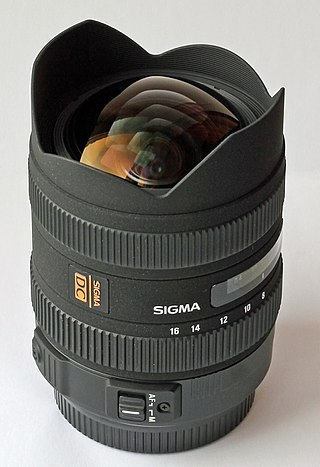
The Sigma 8–16mm lens is an enthusiast-level, ultra wide-angle rectilinear zoom lens made by Sigma Corporation specifically for use with APS-C small format digital SLRs. It is the first ultrawide rectilinear zoom lens with a minimum focal length of 8 mm, designed specifically for APS-C size image sensors. The lens was introduced at the February 2010 Photo Marketing Association International Convention and Trade Show. At its release it was the widest viewing angle focal length available commercially for APS-C cameras. It is part of Sigma's DC line of lenses, meaning it was designed to have an image circle tailored to work with APS-C format cameras. The lens has a constant length regardless of optical zoom and focus with inner lens tube elements responding to these parameters. The lens has hypersonic zoom autofocus.
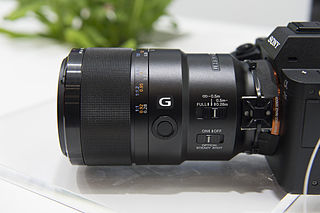
The Sony FE 90mm F2.8 Macro G OSS is a full-frame macro prime lens for the Sony E-mount, announced by Sony on 4 March 2015.

The Sony FE 28mm F2 is a full-frame (FE) wide-angle lens for the Sony E-mount, announced by Sony on March 4, 2015.
The Sony FE 70-200mm F2.8 GM OSS is a premium, constant maximum aperture full-frame (FE) telephoto zoom lens for the Sony E-mount, announced by Sony on February 3, 2016.
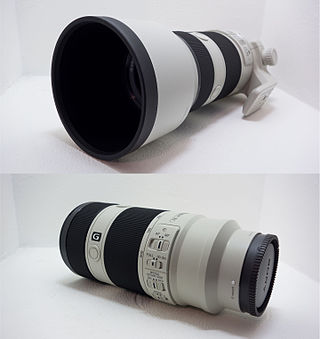
The Sony FE 70-200mm F4.0 G OSS is a full-frame constant maximum aperture, telephoto zoom lens for the Sony E-mount, announced by Sony in 2013.
The Sony FE 70-300mm F4.5-5.6 G OSS is a variable maximum aperture full-frame telephoto zoom lens for the Sony E-mount, announced by Sony in 2016. Though designed for Sony's full frame E-mount cameras, the lens can be used on Sony's APS-C E-mount camera bodies.
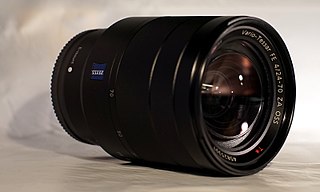
The Sony Zeiss Vario-Tessar T* FE 24-70mm F4 ZA OSS is a constant maximum aperture full-frame (FE) zoom lens for the Sony E-mount, announced by Sony on October 16, 2013.
The Sony FE 50mm F2.8 Macro is a full-frame macro prime lens for the Sony E-mount, announced by Sony on August 30, 2016.
The Tokina Firin 20mm f/2.0 FE MF is a full-frame wide-angle manual focus lens for the Sony E-mount, announced by Tokina on September 8, 2016. It is the first in a new line of Tokina lenses optimized for Sony E-mount, and currently the only Tokina lens offered for Sony full-frame cameras.

The Sony FE 85mm F1.4 GM is a premium short telephoto full-frame prime lens for the Sony E-mount, released by Sony on February 3, 2016.

The Sony FE 24-70mm F2.8 GM is a premium constant maximum aperture full-frame (FE) zoom lens for the Sony E-mount, announced by Sony on February 3, 2016.
The Sony FE 16-35mm F2.8 GM is a premium constant maximum aperture wide-angle full-frame (FE) zoom lens for the Sony E-mount, announced by Sony on May 17, 2017. The lens is scheduled for release on August 31, 2017.
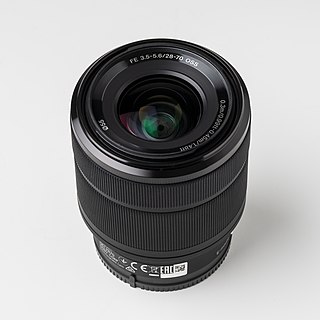
The Sony FE 28-70mm F3.5-5.6 OSS is a full-frame (FE) variable maximum aperture standard zoom lens for Sony E-mount, announced by Sony on October 16, 2013. It was the first kit lens for Sony's full-frame E-mount (FE) system, and was released on the same day as the Sony α7 and Sony α7R. It is often bundled with various Sony E-mount full-frame mirrorless cameras, and is a less costly alternative to other standard zooms such as the Sony Carl Zeiss Vario-Tessar T* FE 24-70mm F4 ZA OSS.
The Sony FE 28-60mm F4-5.6 is a full-frame variable maximum aperture standard zoom lens for the Sony E-mount, announced by Sony on September 14, 2020. It was introduced on the same day as the Sony α7C, for which it is available bundled as a kit lens. At 167g it is the smallest and lightest full-frame zoom lens available for the E-mount.

The Sony FE 20mm F1.8 G is a full-frame wide-angle lens with Sony E-mount bayonet, released in March 2020.

The Nikon Nikkor Z 24-70 mm f/2.8 S is a full-frame standard zoom lens with a constant aperture of f/2.8, manufactured by Nikon for use on Nikon Z-mount mirrorless cameras.













